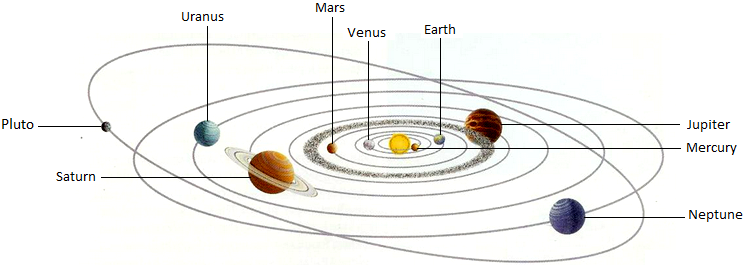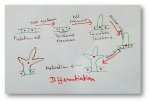The Planets and The Solar System
We will discuss about the planets and the solar system.
We know, our Sun is the nearest star to us. It is about 150 million kilometres away from the Earth. The glowing sun is the most influential heavenly body for our life.
A planet is a big ball of rocks. It does not give out its own heat and light.
There are some heavenly bodies which rotate on their axis and complete one rotation in different periods. They also revolve around the sun along their own fixed paths called orbits. Each orbit is almost elliptical.
A heavenly body rotating on its own axis and revolving around the sun along a fixed elliptical orbit is called a planet.
Our earth is also a planet. The earth and eight other planets move around the Sun. The planets appear bright because they reflect the light of the Sun.
The nine planets, in order of increasing distances from the Sun are Mercury (Budha), Venus (Shukra), Earth (Prithvi), Mars (Mangal), Jupiter (Vrihaspati), Saturn (Shani), Uranus (Arun), Neptune (Varun) and Pluto (Yam). Mercury is the closest planet to the Sun and Pluto is the farthest planet from the Sun.
As we know, these planets move around the Sun in fixed paths called orbits. Some of these planets have smaller objects called moons that move around them. The moon revolves around the earth and completes one revolution in about 30 days. On a clear night we see the moon in the sky. Our Earth has only one moon. The moon is called the satellite of the earth. Like earth some other planets also have satellites. Saturn has the highest number of satellites. Mercury and Venus do not have any satellite. Each satellite revolves around its own planet and in doing so it also revolve around the sun.
There are some small rocky bodies between the orbits of Mars and Jupiter. They revolve around the Sun in a fixed orbit. They are known as asteroids or minor planets.
The Sun and the other heavenly bodies revolving around the sun belong to a family which is called solar system. Thus, the sun, its planets and their satellites and asteroids make the solar system.
From The Planets and The Solar System to HOME PAGE
Recent Articles
-
Differentiation, Dedifferentiation and Redifferentiation | Definition
Apr 21, 25 01:16 PM
Cells from the root apical meristem and shoot apical meristem the camera that differentiate , mature to perform different functions. This process by which the cells undergo different major structural… -
Explain about Growth in Plants |Definition of Growth & Differentiation
Feb 27, 25 02:07 PM
Growth is a permanent increase in length or volume of an organism that brought upon by an increase in its dimensions due to synthesis of new protoplasmic material. -
Definition of Respiratory Quotient | calculation | Application | Plant
Dec 02, 24 12:09 AM
Definition of respiration quotient- the ratio of the carbon-dioxide evolved to that of the oxygen consumed by a cell, tissue, plants or animals in a given time is called respiratory quotient. It is us… -
Amphibolic Pathway | Definition | Examples | Pentose Phosphate Pathway
Jun 06, 24 10:40 AM
Definition of amphibolic pathway- Amphibolic pathway is a biochemical pathway where anabolism and catabolism are both combined together. Examples of amphibolic pathway- there are different biochemical… -
Respiratory Balance Sheet | TCA Cycle | ATP Consumption Process
Feb 18, 24 01:56 PM
The major component that produced during the photosynthesis is Glucose which is further metabolised by the different metabolic pathways like glycolysis, Krebs cycle, TCA cycle and produces energy whic…





New! Comments
Have your say about what you just read! Leave me a comment in the box below.